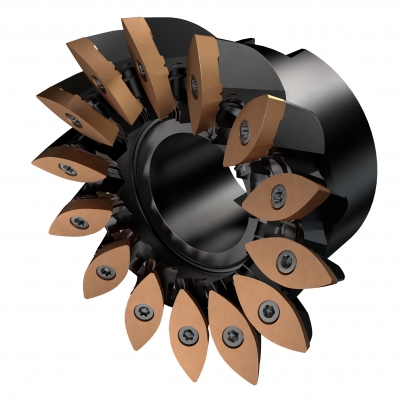
A new power skiving solution composed of CoroMill 178 and CoroMill 180 (pictured) cutters from Sandvik Coromant is being released to help automotive manufacturers complete gear and spline components in one setup on a multitask machine or machining center. Skiving processes are many times faster than shaping and more flexible than broaching, and are quickly becoming an efficient and flexible alternative for gear and spline production.
The power skiving solution from Sandvik Coromant comprises solid bore, solid shank and indexable cutters. CoroMill 178S (solid carbide) is for use in applications where high-volume, high-rpm machining with long tool life is required, while CoroMill 178H (powder metallurgy HSS) is for general use on shoulders or small diameters. These tools offer the highest tool accuracy with regard to run-out and pitch compared to indexable tools, providing a better finishing profile of the gear and spline. Reconditioning can typically be performed up to 10 times depending on the quality of the tool.
CoroMill 180 indexable cutters are for high-volume roughing on a large range of gears (module 2-9). Among many notable features are a positive rake angle for light cutting action and the potential for dry machining, which saves on coolant costs and helps to protect the environment.
“The power skiving cutter selection can provide both high output and an optimized finishing profile,” says Harish Maniyoor, global product manager, automotive industry segment at Sandvik Coromant. “Coupled with the ability for one set-up machining, the tools improve quality and save time and cost. In fact, cycle time reductions of circa 50% can be anticipated compared to gear shaping, helping to reduce the cost per component considerably. It is also worth noting that skiving is more flexible than hobbing for producing new, compact automotive transmissions.”
All tools are made as engineered solutions to meet precise customer needs. With the correct design, processes at the production level will prove up to 15 times faster than shaping and more flexible than broaching, with better quality. The development also brings greater process flexibility to end customers, moving production to in-house machining centers and away from dedicated machine tools at suppliers’ locations. Moreover, process reliability will increase, with fewer unplanned stops.
Manufacturers in the automotive industry are among those set to benefit the most, as the tools support new developments in hybrid cars, as well as electromobility for cars, trucks, tractors and excavators. Typical applications include internal and external gears and splines, in addition to cylindrical spur and helical gears for automotive transmissions, and a variety of other gears, coupling components, splines, shafts, synchronization rings and CV joint parts.
Contact Details
Related Glossary Terms
- broaching
broaching
Operation in which a cutter progressively enlarges a slot or hole or shapes a workpiece exterior. Low teeth start the cut, intermediate teeth remove the majority of the material and high teeth finish the task. Broaching can be a one-step operation, as opposed to milling and slotting, which require repeated passes. Typically, however, broaching also involves multiple passes.
- centers
centers
Cone-shaped pins that support a workpiece by one or two ends during machining. The centers fit into holes drilled in the workpiece ends. Centers that turn with the workpiece are called “live” centers; those that do not are called “dead” centers.
- coolant
coolant
Fluid that reduces temperature buildup at the tool/workpiece interface during machining. Normally takes the form of a liquid such as soluble or chemical mixtures (semisynthetic, synthetic) but can be pressurized air or other gas. Because of water’s ability to absorb great quantities of heat, it is widely used as a coolant and vehicle for various cutting compounds, with the water-to-compound ratio varying with the machining task. See cutting fluid; semisynthetic cutting fluid; soluble-oil cutting fluid; synthetic cutting fluid.
- machining center
machining center
CNC machine tool capable of drilling, reaming, tapping, milling and boring. Normally comes with an automatic toolchanger. See automatic toolchanger.
- pitch
pitch
1. On a saw blade, the number of teeth per inch. 2. In threading, the number of threads per inch.
- rake
rake
Angle of inclination between the face of the cutting tool and the workpiece. If the face of the tool lies in a plane through the axis of the workpiece, the tool is said to have a neutral, or zero, rake. If the inclination of the tool face makes the cutting edge more acute than when the rake angle is zero, the rake is positive. If the inclination of the tool face makes the cutting edge less acute or more blunt than when the rake angle is zero, the rake is negative.
- shank
shank
Main body of a tool; the portion of a drill or similar end-held tool that fits into a collet, chuck or similar mounting device.
- shaping
shaping
Using a shaper primarily to produce flat surfaces in horizontal, vertical or angular planes. It can also include the machining of curved surfaces, helixes, serrations and special work involving odd and irregular shapes. Often used for prototype or short-run manufacturing to eliminate the need for expensive special tooling or processes.







